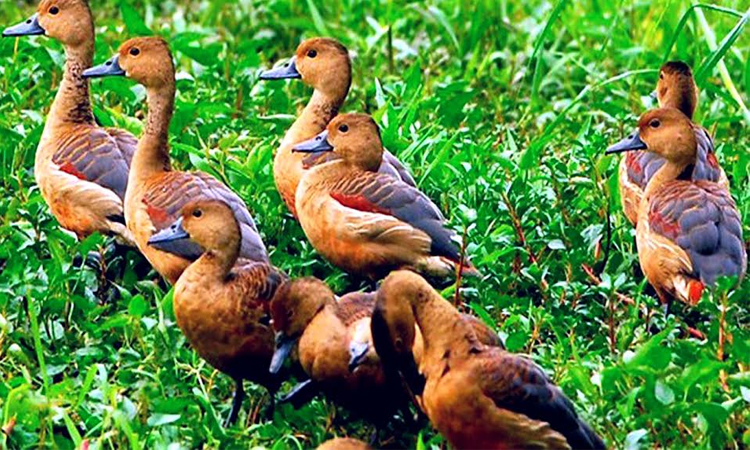News Flash
News Flash

By Md Mamun Islam
RANGPUR, Nov 16, 2025 (BSS) – The arrival of guest birds from the northern hemisphere before the onset of winter in the northern region is creating a natural, festive, and soothing atmosphere in the rivers, canals, beels, and water bodies.
Amid the adverse effects of climate change, migratory birds are arriving in the region a little earlier this time compared to previous years, although they would usually arrive from December in previous decades.
With the arrival of migratory birds, rivers, beels, and other water bodies are gradually being transformed into scenic spots, which is now delighting people from all walks of life.
Meanwhile, many people are enjoying the beautiful flying, swimming, and chirping of migratory birds in rivers and water bodies, which have turned the surrounding nature into beautiful sights.
Talking to BSS, environmental experts, observers, and common people said that the number of migratory birds arriving from the cold northern hemisphere could be relatively higher this year compared to previous years.
After arriving in rivers and other water bodies, migratory birds survive by eating small fish, insects, small snails, plants and animals, and aquatic plants, which are still abundant in northern water bodies.
Begum Rokeya University Professor and Director of Riverine People, environmentalist Dr. Tuhin Wadud, told BSS that even four decades ago, many migratory birds could be seen in the rivers and water bodies in the Brahmaputra basin of the northern region.
The number of migratory birds arriving declined in recent years due to the reduction in the number and area of water bodies and the loss of plants, animals, and abundant freshwater fish from wetlands due to climate change.
However, it is a pleasing event and good news that the number of arriving migratory birds is comparatively higher during the current winter season.
“If the deteriorating climate change situation continues, the number of migratory birds arriving may start to decline again due to a lack of their food in the shrinking water bodies in the northern region,” Dr. Tuhin feared.
Chairman of the Northbengal Institute of Development Studies Dr. Syed Samsuzzaman said that climate change has increased average temperatures in the Himalayan, Siberian, Xinjiang, and Mongolian regions, making these places suitable to some extent for bird habitats even in winter.
“As a result, the number of migratory birds arriving in northern water bodies decreased in recent years,” he said, expressing satisfaction that the number of migratory birds this season is slightly higher.

Locals said migratory birds have been arriving in the Brahmaputra, Teesta, Jamuna, and other rivers and Ramsagar Dighee in Dinajpur, Chatra Beel in Rangpur, and many other water bodies in the northern region.
Visitors are rushing to the Ramsagar Dighee in Dinajpur to witness migratory birds and the pleasant moments of their flying and coming down on the water again and again.
Similarly, migratory birds are arriving in the Neel Sagar Dighee in Nilphamari, where common people are enjoying the pleasant arrival and well-mannered flying and movement of the birds, giving nature a decent fleeting glimpse.
Superintending Engineer of Barind Multipurpose Development Authority (BMDA) for Rangpur Circle, Engineer Md Habibur Rahman Khan, said that migratory birds have already started arriving in the rivers, beels, and water bodies of the northern region.
Migratory birds like Chhota Sarali, Bara Sarali, Bali Lenja, Bali Duck, Pati Merganser, Common Merganser, Balihans, Bhulihans, Khuntehans, Uttorer Titi, Pintail Duck, Gurgani, Khopa Duburi, Machh Mural, Kan Pecha, Tisabaz, Ziriya, Titi, Monmcand, Chokhachokhi, Neel Kuthi Patihansh, Red Jhuti Bhutihans, Baro Khopa Duburi, Shah Chokha, Porijayee Rajhans, and Dagi Rajhans are mostly arriving in the Brahmaputra basin.
The vast watery area of BMDA's re-excavated Bharardaho Beel in Badarganj upazila of Rangpur, circled by a wide bank, and home to flora, fauna, and 6,500 trees of 213 species of rare timber, fruit, medicinal, and flowering plants, has become a sanctuary for migratory birds.
“The entire beel area is now gradually being filled with the chirping of guest birds and the sound of their wings fluttering freely and flying gracefully, attracting many visitors to enjoy this scenic display,” Habibur Rahman Khan said.
Housewife Gulnahar Begum came to Bharardaho Beel with her husband Arifuzzaman Arif and son Amiruzzaman, 13, and daughter Aklima, 10, to enjoy the aesthetic beauty there on Saturday.
“The orderly flight of migratory birds in the air, their chirping, and their swimming on the water created a heart-warming, divine scene in which I enjoyed divine peace and tranquility,” she said.
Arifuzzaman Arif, Amiruzzaman, and Aklima said they were fascinated while enjoying the beauty of Bharardaho Beel, which includes the chirping of guest birds, green nature like a botanical garden, and blooming flowers.